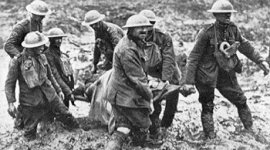
THREE DIMENSIONAL FORGIVENESS
There is rich texture to the aftermath of Easter which exposure to the lazy storytelling rituals of today causes us to miss.
You may agree with me that films have become formulaic and predictable today. In the same way that people like shopping in the same supermarkets and eating in the same restaurants, they prefer their stories to follow the same rituals. Film companies have to make profits and the surest way of doing this is to follow what has worked in the past. You want a hit romantic comedy? Hire Richard Curtis to write it and get Hugh Grant and Colin Firth to fight over a cute but dippy Home Counties girl with the winner embracing her in the snow in St. James Park in the end. You want an action thriller? Get Paul Greengrass to direct a lot of jerky hand-held camera scenes with confusing and claustrophobic fights involving Matt Damon. And woe betide any producer who wants to break the convention of a happy ending. Childhood fairy tales continue to influence adult emotions. The good guys have to beat the bad guys and the nicer guy has to get the woman. While computer generated images grow more stunning by the year, characters are becoming more two-dimensional. Don’t expect the modern movie theatre to show you the emotional effects of being shot or bereaved; the pain of unrequited love or crushed desire. These are too complicated and introspective for the cinema.
In celebrating Easter we are in danger of a similar failure of imagination. Like those movies where everything is fine to start with, then things go wrong before finally being put right again at the end, many people think of Jesus having a great life, a horrible death, but a nice resurrection where he and his friends live happily ever after. And everyone is so pleased for him – such a nice man. Today’s formulaic stories end with life returning to normal, with perhaps a new romance thrown in. The best stories, by contrast, explore human responses to evolving circumstances and examine how lives are scarred by those experiences. The Easter story is a perfect example of this.
After the resurrection of Jesus, nothing returns to how it was before – everything changes. It is a mistake to think the followers of Jesus felt unmitigated joy and boundless faith in the resurrection. As the early hours unravelled afterwards, there was a mixture of joy, fear, doubt, uncertainty, awkwardness and embarrassment among his friends. For Mary meeting Jesus in the garden there was joy in seeing a dead man take a morning stroll. It was like the fulfilment of a bereavement fantasy where the person you grieve for walks into the room to prove it’s all been a terrible dream.
The giddiness Mary felt may only have confirmed to her friends that she had lost touch with reality in her grief. Even for those who felt joy, doubts crept in. This was so outside the realm of human experience that it was natural to question it, just as people do today. Doubting Thomas may have been singled out in John’s Gospel for his hesitancy but he was a figurehead for several others who couldn’t bring themselves to believe the evidence either. When confronted with Jesus, some were overwhelmed more by fear than joy, thinking they were encountering a ghost of some kind.
There was tangible awkwardness because the last day of Jesus had found many of them wanting. Having deserted Jesus in his darkest hour, the best hope his friends then had was to rewrite history so it would look a little more kindly on them. The re-appearance of Jesus put paid to that, requiring them painfully to confront their own failings. Could we have looked him in the eye after running away from his arrest scene three days earlier? There was joy among his friends that day, but there was also something hanging heavily in the air between them, an unresolved tension which spoiled the mood.
This conflict came to a head later when the disciples met with Jesus by the Sea of Galilee (John 21), where he made an explicit point of forgiving and restoring Peter for his threefold denial in the High Priest’s courtyard. But the context of this event is just as significant. Jesus had risen from the dead – and the disciples’ response had been to go back to their day job, fishing, as if their life with Jesus had never happened. They had not been able to make sense of it and in the absence of a brighter idea, had fallen back on old habits. Only when the Holy Spirit came upon them at Pentecost were they able to absorb the global, historic implications of this good news.
In other words, the response to the resurrection from those who witnessed it was only a provisional ‘praise the Lord’. It took them much longer to get their act together. In the same way our responses differ to this story. Some of us may feel great joy because he is risen from the dead and we believe it. Some of us may have doubts like Thomas – empirical questions we can’t answer like a maths puzzle we can’t solve - and yet still we come to church because we know there’s something there we can feel but not define. Some of us may believe it but feel compromised by lives we feel are unworthy of a Christian – like Peter who at the end let down the one he had given everything up for. Still others of us may believe it but deep down feel we are living no differently to the guy next door we are quite sure doesn’t believe in it – just like the disciples on Galilee who took up fishing again with everyone else in the neighbourhood who never gave it up when Jesus came calling in the first place.
Wherever we stand on the Easter story, we can be sure to find a patron saint in those first disciples who felt just the same way. Yet before we get too settled in our position, we should recall the way they shed their indecision in such a dramatic way that just a handful of them changed the world for ever.
The New Testament tells us that every Christian has died with Christ on the cross, meaning we are dead people. Handling this truth is hard because it tells us we are no longer our own –what we were has died with him. But it is only part of the truth because every Christian who has died with Christ is also alive with his resurrection life. This is the key to moving on in our understanding of the Christian faith – living in the truth of it and believing it of ourselves transforms our whole life. The same Paul who said ‘I have been crucified with Christ’ went on to say ‘I want to know Christ and the power of his resurrection’.
In this age of cynicism and false humility, many Christians are diffident about living lives which look joyful and assured in their belief. Yet it was just those qualities which turned the ancient world to Christ. There was nothing two-dimensional about this – their lives had been scarred forever by the experience of going through that traumatic Easter weekend with Jesus. Today’s formulaic script writers would have ended the story with Jesus returning to Galilee to settle down and marry, living happily ever after with his friends as if the pain and distress of his death had never happened. But the Gospel didn’t end with John 21 by the lake. In fact it began there, as his friends looked him in the face and felt their doubt and failure dissolve into the indestructible new life he had gifted them – and every follower since.
POPULAR ARTICLES

Obama's Covert Wars
The use of drones is going to change warfare out of all recognition in the next decades.

Through A Glass Starkly
Images of traumatic incidents caught on mobile phone can be put to remarkable effect.

What Are British Values?
Is there a British identity and if so, what has shaped the values and institutions that form it?


